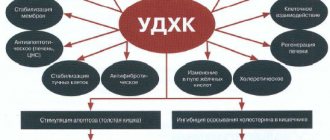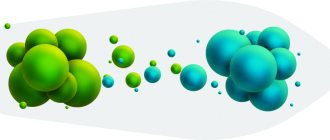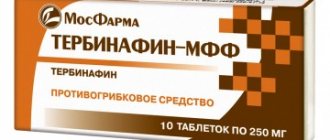Hopanthenic acid 500 mg, 50 tablets (Ozone)
Registration Certificate Holder
ATOLL (Russia)
Dosage form
Medicine - Hopantenic acid
Description
Pills
white or almost white, round, flat-cylindrical, with a chamfer and a notch.
1 tab.
calcium hopantenate 500 mg
Excipients
: magnesium hydroxycarbonate - 93.6 mg, povidone K25 - 20.2 mg, calcium stearate - 6.2 mg.
10 pieces. — cellular contour packages (1) — cardboard packs. 10 pieces. — contour cell packaging (2) — cardboard packs. 10 pieces. — cellular contour packages (3) — cardboard packs. 10 pieces. — contour cell packaging (4) — cardboard packs. 10 pieces. — contour cell packaging (5) — cardboard packs. 10 pieces. — contour cell packaging (10) — cardboard packs. 20 pcs. — cellular contour packages (1) — cardboard packs. 20 pcs. — contour cell packaging (2) — cardboard packs. 20 pcs. — cellular contour packages (3) — cardboard packs. 20 pcs. — contour cell packaging (4) — cardboard packs. 20 pcs. — contour cell packaging (5) — cardboard packs. 20 pcs. — contour cell packaging (10) — cardboard packs. 25 pcs. — cellular contour packages (1) — cardboard packs. 25 pcs. — contour cell packaging (2) — cardboard packs. 25 pcs. — cellular contour packages (3) — cardboard packs. 25 pcs. — contour cell packaging (4) — cardboard packs. 25 pcs. — contour cell packaging (5) — cardboard packs. 25 pcs. — contour cell packaging (10) — cardboard packs. 30 pcs. — cellular contour packages (1) — cardboard packs. 30 pcs. — contour cell packaging (2) — cardboard packs. 30 pcs. — cellular contour packages (3) — cardboard packs. 30 pcs. — contour cell packaging (4) — cardboard packs. 30 pcs. — contour cell packaging (5) — cardboard packs. 30 pcs. — contour cell packaging (10) — cardboard packs. 10 pieces. - cans (1) - cardboard packs. 20 pcs. - cans (1) - cardboard packs. 25 pcs. - cans (1) - cardboard packs. 30 pcs. - cans (1) - cardboard packs. 50 pcs. - cans (1) - cardboard packs. 100 pieces. - cans (1) - cardboard packs.
Indications
Cerebrovascular insufficiency caused by atherosclerotic changes in cerebral vessels, senile dementia (initial forms), residual organic brain damage in mature and elderly people, cerebral organic insufficiency in patients with schizophrenia, extrapyramidal hyperkinesis in patients with hereditary diseases of the nervous system (including Huntington's chorea, hepatocerebral dystrophy, Parkinson's disease), residual effects of previous neuroinfections, post-vaccination encephalitis, traumatic brain injury (as part of complex therapy); extrapyramidal neuroleptic syndrome (hyperkinetic and akinetic), as a corrector of the side effects of antipsychotics (neuroleptics) and for preventive purposes at the same time as “cover therapy”; epilepsy (with slow mental processes in combination with anticonvulsants). Psycho-emotional overload, decreased mental and physical performance (increased concentration and memory). Urinary disorders: enuresis, daytime urinary incontinence, pollakiuria, urgency (adults and children over 2 years old).
Children: perinatal encephalopathy, mental retardation (delayed mental, speech, motor development or a combination thereof), cerebral palsy, stuttering (mainly clonic form), epilepsy (as part of combination therapy with anticonvulsants, especially with polymorphic seizures and petit mal seizures) .
Contraindications for use
Acute severe kidney disease, first trimester of pregnancy.
pharmachologic effect
A nootropic agent that has neurometabolic, neuroprotective and neurotrophic properties. Increases the brain's resistance to hypoxia and the effects of toxic substances, stimulates anabolic processes in neurons, combines a moderate sedative effect with a mild stimulating effect, has an anticonvulsant effect, reduces motor excitability while regulating behavior. Increases mental and physical performance. Helps normalize GABA content during chronic alcohol intoxication and subsequent ethanol withdrawal. Shows analgesic effect.
Drug interactions
Prolongs the effect of barbiturates, enhances the effects of anticonvulsants, nootropics and central nervous system stimulants, and the effect of local anesthetics (procaine).
Prevents side effects of phenobarbital, carbamazepine, antipsychotics (neuroleptics).
The effect of hopantenic acid is enhanced in combination with glycine and xydiphone.
Dosage regimen
Taken orally. Single dose for adults - 0.5-1 g, for children - 0.25-0.5 g; daily dose for adults - 1.5-3 g, for children - 0.75-3 g. The course of treatment is 1-4 months, in some cases - up to 6 months. After 3-6 months, a second course of treatment is possible.
For children with mental impairment and mental retardation - 0.5 g 4-6 times a day daily for 3 months; for delayed speech development - 0.5 g 3-4 times a day for 2-3 months.
As a corrector for neuroleptic syndrome, adults - 0.5-1 g 3 times/day, children - 0.25-0.5 g 3-4 times/day. The course of treatment is 1-3 months.
For epilepsy, children - 0.25-0.5 g 3-4 times a day, adults - 0.5-1 g 3-4 times a day, daily, for a long time (up to 6 months).
For tics in adults - 1.5-3 g/day, daily, for 1-5 months; children - 0.25-0.5 g 3-6 times a day daily for 1-4 months.
For urinary problems in adults - 0.5-1 g 2-3 times a day, daily dose - 2-3 g; for children, a single dose is 0.25-0.5 g, daily - 25-50 mg/kg. The course of treatment is 0.5-3 months.
Side effect
Allergic reactions:
rhinitis, conjunctivitis, skin rashes.
special instructions
Long-term therapy with hopantenic acid in combination with other nootropic and central nervous system stimulants is not recommended.
Use during pregnancy and breastfeeding
Restrictions during pregnancy - Contraindicated.
Use is contraindicated in the first trimester of pregnancy.
Use for renal impairment
Restrictions for impaired renal function - Contraindicated.
The drug is contraindicated in acute severe kidney disease.
Use in children
Restrictions for children - No restrictions.
Application is possible according to the dosage regimen.
Chemical properties
Hopanethic acid is usually represented by the calcium salt of D-(+)-a, g-dioxy-b, b-dimelbutyryl-aminobutyric acid or D-(+)-homopantothenic acid . The chemical structure of calcium hopantenate is similar to the molecule pantothenic acid , gamma-aminobutyric acid . The substance is synthesized in the form of a white crystalline powder, which is highly soluble in water, but poorly soluble in alcohols.
The pH value of a 5% aqueous solution is from 7 to 9. The medicine is available in the form of syrup for oral administration or tablets.
Hopanthenic acid, instructions for use (Method and dosage)
Tablets and syrup are prescribed orally. 20-30 minutes after eating.
On average, a single dosage for an adult ranges from 500 mg to 1 gram. For children, it is necessary to adjust the dosage: 250-300 mg at a time. The recommended daily dose for an adult is from 1.5 to 3 grams, for a child – 700 mg or 3 grams. In general, the dosage regimen and duration of treatment depend on the doctor’s recommendations.
The course of treatment ranges from one to 4 months, maximum – half a year. You can repeat the course after 3-6 months.
For the treatment of mental deficiency or mental retardation in children, 500 mg of the drug is used, 4-6 times a day. Duration of treatment – 3 months.
For delayed speech development, children are prescribed from 0.25 g to 500 mg, 3-4 times a day. The substance is taken from 30 days to 3 months (depending on condition).
Children with epilepsy during treatment with antiepileptic drugs are advised to take 0.75-2 grams of the substance in 3-4 doses. For adults, the daily dosage is 1.5-4 grams. The duration of treatment is from 1 to 6 months, depending on the doctor’s recommendations.
To eliminate tics in adults, use 1.5-3 grams of Hopantenic acid per day (3-4 times a day). The course of treatment is from 30 days to 5 months. For children, the daily dosage is from 0.75 to 3 grams. The medicine is taken 3 to 6 times a day, for 2-4 months.
For enuresis or various urinary disorders, adults are prescribed 500 mg or 1 gram of the drug, 2-3 times a day. Children are prescribed 250-500 mg at a time. Duration of treatment is up to 3 months.
Reviews about Hopantenic acid
Some reviews about Hopantenic acid:
- “... My son speaks poorly, during the next examination by a neurologist, the doctor prescribed Hopantenic acid. After a 2-month course of the drug, my son showed noticeable improvements, he began to pronounce sounds more clearly. My child has become more active and his memory has improved. I’ve been taking the pills for 2 months now, I haven’t noticed any side effects”;
- “...The child had hypoxic syndrome. The doctor prescribed me to take Hopantenic acid. After completing the course (1.5 months), my daughter’s condition improved, and the results of the control ultrasound were very pleasing. Then the child was treated with another drug, but most importantly, it was this drug that helped us initially.”
Some doctors prescribe this drug in order to be on the safe side; in this case, after treatment with the substance, the patient does not experience any positive effect. Adverse reactions occur rarely.
Preparations containing (Hopantenic acid analogues)
Level 4 ATX code matches:
Bravinton
Acefen
Carnicetine
Pyracesin
Nooclerin
Semax
Piracetam
Olatropil
Fezam
Vinpocetine
Cerebrocurin
Cavinton Forte
Calcium hopantenate
Glutamic acid
Cephabol
Olanzapine
Cerebrolysate
Pramistar
Sidnocarb
Vinpotropil
The substance has the following trade names: Gopantam, Calcium hopanthenate, Hopanthenic acid, Pantogam tablets and syrup, Calcium salt of Hopanthenic acid, Pantocalcin, Cognum .
Interaction
Xidifon and glycine enhance the effect of calcium hopantenate .
The substance increases the effectiveness of nootropics , central nervous system stimulants , anticonvulsants, antiepileptic drugs , local anesthetics ( procaine ).
When taking medications and barbiturates, the duration of action of the latter increases.
The drug has the ability to reduce the likelihood and severity of adverse reactions from carbamazepine , antipsychotics and phenobarbital .
Pharmacodynamics and pharmacokinetics
The calcium salt of Hopanthenic acid has neurotrophic , neurometabolic and neuroprotective properties . The nootropic increases the resistance of brain tissue to the effects of toxins , stimulates anabolic processes in neurons, and reduces the brain's need for oxygen under hypoxic . Medicines containing this substance have a mild stimulating and moderate sedative effect.
The drug reduces the seizure threshold and eliminates excessive motor excitability. The patient's mental and physical performance increases, the level of gamma-aminobutyric acid (especially with constant ethanol ). The medicine has a weak analgesic effect and regulates behavior.
After the drug penetrates the gastrointestinal tract, it is quickly absorbed by the body. The maximum acid concentration is observed after 60 minutes. The substance penetrates the blood-brain barrier well; small concentrations can be found in the kidneys, skin, liver and stomach walls. The drug is not metabolized in the body. The medicine is completely eliminated from the body within 2 days. Most of the active component is excreted in the urine, less than 30% in feces.



